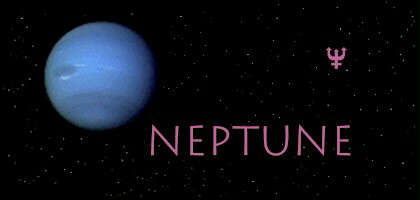|
|
|

|
Neptune is the eighth planet from the Sun and the fourth largest (by diameter). In Roman mythology Neptune was the god of the sea.
Neptune represents our imagination, our ideals, inspiration, spirituality, fantasy, self-less service to others. "Forget the real world, my dreams are enough", that is Neptune. Where it falls, is where you experience difficulties and can be deluded. At the same time, there is a deep sense of obligation to the affairs of that house. You may feel internal pressure to plunge into the house affairs. Frequently there are problems that other people cannot see.
As the modern ruler of Pisces and the higher octave of Venus, Neptune is associated with the subtle, yet invasive forces that obscure and obfuscate. Reality and non-Reality become confused as boundaries blur and we are forced to rely on our own inner guidance system. It is the opposite of "solid", just like its physical characteristics. It is Neptune’s job to put us in touch with the true Reality, that which we create. Neptune is associated with idealism, compassion, self-sacrifice, vagueness, illusion, deception, as well as art, poetry, films, glamour, dance, music, and inspiration.
Physically, Neptune rules the feet, toes, malformations, leakage, toxic conditions, and infectious organisms.
For colors, gemstones, and metals, Pisces is associates with sea green, silver, violet, and purple; the gem of aquamarine and bloodstone; and the metal of tin.
![]()
![]() Astronomical
data:
Astronomical
data:
Voyager 2 added six small moons to Neptune's known brood, all relatively close to the planet. Tiny Nereid, the outermost moon, occupies the most eccentric orbit of any moon in the solar system. But Triton is the most curious of Neptune's satellites. It is the only large moon in the solar system to orbit 'backwards' around its planet. Voyager 2 found Triton to have a tenuous nitrogen atmosphere, the coldest surface temperatures in the solar system, an enormous polar cap of nitrogen ice and active geyser-like plumes erupting through the ice cap. Triton may well be a Pluto-like object, formed independently of Neptune in the outer solar system but later "captured" by the planet's gravity.
Neptune presents a more active atmosphere than does Uranus. It has a hurricane-like feature, similar to the Red Spot on Jupiter, called the Great Dark Spot. Accompanying this large storm are a few smaller ones named D2 (dark spot 2) and Scooter. Neptune is over 50 percent farther from the Sun than its near twin in size and appearance, Uranus, but its temperature is equal to or slightly greater than that of Uranus. Its internal energy is such that it emits nearly 2.5 times as much energy as it receives from the Sun. The escaping internal energy may also power the storms and winds in Neptune's atmosphere, which are the fastest in the solar system.
Like the other gas giant planets, Neptune probably has no solid surface. The planet's observable atmosphere is primarily hydrogen and helium, and it owes its beautiful blue color to an abundance of methane in its atmosphere, which absorbs red light and reflects blue. High clouds of methane ice cast shadows on deeper, possibly ammonia, ice crystal clouds.
Earth-based observations had hinted at a system of broken rings, or arcs around Neptune, and Voyager 2's images revealed a sparse but continuous ring system. Neptune's outermost ring has three dense areas. The next ring in is also narrow but without denser ring arc regions. Two broad inner regions of ring material complete the neptunian ring system. The rings are embedded in a magnetic field tilted 50 degrees to Neptune's equator and offset from the center of the planet by more than half of its radius.
[Sun] [Moon] [Mercury] [Venus] [Mars]
[Jupiter] [Saturn] [Uranus] [Neptune] [Pluto]
*Astrological Backgrounds Menu*
![]()